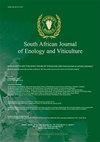潜在的烟雾污染的红葡萄酒:挥发性酚和香气属性
IF 1.1
4区 农林科学
Q4 FOOD SCIENCE & TECHNOLOGY
引用次数: 8
摘要
包括挥发性酚(VPs)在内的恶臭化合物在葡萄酒中的浓度通常低于其气味阈值,因此可能被认为对葡萄酒质量没有威胁。大多数对烟雾污染的调查都是通过化学/分析手段量化化合物,或者研究模型酒中超过和接近阈值的污染的感官影响。在这个项目中,使用GC-MS筛选了12种葡萄酒(由南非行业提交的潜在烟雾污染),并通过在烟雾污染评估方面训练有素的感官小组使用描述性分析(DA)进行了表征。结果进行了统计比较,阐明了化学特性和感觉特性之间的关系。使用组合数据集证明,葡萄酒中VPs的浓度和组成与某些感官属性具有良好的相关性。愈创木酚在大多数样品中以接近或超过阈值的水平存在,但与污染无关,除非与其他酚类化合物结合,在这种情况下,愈创木酚与“烟熏”、“灰熏”和“草本”属性有关。VPs超过阈值水平的葡萄酒显示出负面属性(“化学/塑料”、“焦油/ BR”和“药用/弹性塑料”)。在某些情况下,感觉效应(“泥土/尘土/土豆皮”,“发霉/发霉”和“煮熟的蔬菜(蔬菜)”)不能归因于超阈值VP污染,因此似乎是由于阈值以下VP的组合。在许多葡萄酒中发现了负面属性与收获前的历史丛林大火事件之间的联系。本研究强调了了解副总裁对葡萄酒香气影响的重要性,以及葡萄酒行业对这些问题的认识和敏感性不断提高。本文章由计算机程序翻译,如有差异,请以英文原文为准。
Potentially Smoke Tainted Red Wines: Volatile Phenols and Aroma Attributes
Malodourous compounds, including volatile phenols (VPs) are frequently found at concentrations below their odour thresholds in wine, and may therefore be considered to present no threat to wine quality. Most investigations into smoke taint quantify compounds by chemical/analytical means, or investigate sensory effects of supra- and peri-threshold contamination in model wine. In this project, twelve wines (submitted by the South African industry as potentially smoke tainted) were screened for VPs using GC-MS, and characterized using descriptive analysis (DA) by a sensory panel highly trained in smoke taint evaluation. Results were compared statistically to elucidate relationships between chemical and sensory characteristics. It was demonstrated, using the combined dataset that concentration and composition of VPs in the wines correlated well with certain sensory attributes. Guaiacol was present in most samples at peri- or suprathreshold levels, but was not correlated with taint unless in combination with other phenols, in which case it was associated with ‘smoky’, ‘ashy’ and ‘herbaceous’ attributes. Wines with supra-threshold levels of VPs showed negative attributes (‘chemical / plastic’, ‘tar / BR’ and ‘medicinal / Elastoplast™’). In some cases, sensory effects (‘earthy / dusty / potato skin’, ‘mouldy / musty’ and ‘cooked vegetables (veg.)’) could not be attributed to supra-threshold VP contamination, and therefore seemed to be due to combinations of VPs at subthreshold levels. Associations between negative attributes and historical bushfire events prior to harvest were found for a number of the wines. This study emphasizes the importance of understanding effects of VPs on wine aroma, and escalating awareness and sensitivity to these issues in the wine industry.
求助全文
通过发布文献求助,成功后即可免费获取论文全文。
去求助
来源期刊
CiteScore
2.50
自引率
7.70%
发文量
1
审稿时长
>36 weeks
期刊介绍:
The South African Journal of Enology and Viticulture (SAJEV) publishes full-length original Research Papers, Research Notes and Review Papers on all subjects related to enology and viticulture. The SAJEV does not accept articles published in, or submitted to, other journals.

 求助内容:
求助内容: 应助结果提醒方式:
应助结果提醒方式:


